




![]()
The tiny creatures that live in the Savannah River’s flood plain and the fish that feed on them can tell a lot about the river’s health and may help regulators better manage it.
A healthy river has a natural pulse, one that creates a flood plain when water flows over its banks during heavy rainfall, said Darold Batzer, a research entomologist in UGA’s College of Agricultural and Environmental Sciences.
Batzer studies water-dwelling invertebrates, like fly and mosquito larvae and microscopic crustaceans. Invertebrates feed on plant matter and are close to the bottom of the food chain, which makes them a critical link to a healthy animal population.
“The main river is tied to what happens in the flood plains,” said Batzer. “Much of the energy for the fish comes from the flood plain, and if you break that link, you have a negative impact on the river.”
For a half century, the Savannah River’s flow has been controlled by a series of dams managed by the U.S. Army Corps of Engineers. This control has restricted the river’s natural flooding, or pulse. Conservation groups, concerned over the issue, have asked for research Batzer said.
Cooperating with The Nature Conservancy, the corps now wants to manage the flow to improve the overall health of the river and the organisms, small and large, that live in and around it.
“Some people think floods need to be controlled,” Batzer said. “But in many ways they are what make Southeastern rivers tick.”
With funding from TNC and the U.S. Geological Survey, Batzer studied the invertebrates and fish in the river’s flood plain. Over the past three years, the corps carried out new flow scenarios to mimic the river’s natural pulse in an effort to restore ecosystems.
Batzer studied the Altamaha River for six years to gain insights about features of a natural, unregulated flood plain. By learning how many and which species of invertebrates and fish are in the Altamaha flood plain, regulators will better understand how the Savannah flood plain should be managed.
The Altamaha usually has one big flood, or pulse, at least once a year if there is no drought, according to Batzer. The water flows over the banks and remains for a few weeks, filling swamps for a few months. Smaller pulses can reconnect the swamps throughout the year.
Batzer has collection sites throughout both plains. He and his team use core samples and nets to collect the invertebrates and mild electric shock to collect the fish.
The Altamaha’s flood plain is much more dynamic than Savannah’s plain, he said. And it includes hundreds of invertebrate species and dozens of fish species.
Creatures like the dytiscid beetles (left)and fingernail clams are easily found in the Altamaha plain, but not in the Savannah plain. Mosquito larvae are more common on the Savannah plain, he said. With little to no flooding, the fish in the Savannah River can’t get to the larvae and eat them in the rain-fed pools created on the flood plain there.
It’s too early to know whether the corps’ new efforts on the Savannah River are working, said Batzer. “It will take many years to detect a recovery of the system.”
The Savannah River flows along the border between Georgia and South Carolina and is about 350 miles long. The Altamaha River begins near Hazlehurst, GA, in southeast Georgia and runs 140 miles south to the Atlantic Ocean.
For more information, contact Darold Batzer at dbatzer@uga.edu.
For comments or for information please e-mail: rcomm@uga.edu
To contact the webmaster please email: ovprweb@uga.edu
![]()